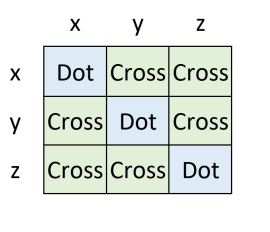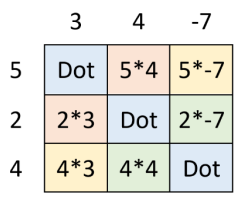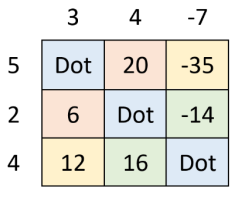3.6: The Cross Product- Algebra
- Page ID
- 125040
\( \newcommand{\vecs}[1]{\overset { \scriptstyle \rightharpoonup} {\mathbf{#1}} } \)
\( \newcommand{\vecd}[1]{\overset{-\!-\!\rightharpoonup}{\vphantom{a}\smash {#1}}} \)
\( \newcommand{\id}{\mathrm{id}}\) \( \newcommand{\Span}{\mathrm{span}}\)
( \newcommand{\kernel}{\mathrm{null}\,}\) \( \newcommand{\range}{\mathrm{range}\,}\)
\( \newcommand{\RealPart}{\mathrm{Re}}\) \( \newcommand{\ImaginaryPart}{\mathrm{Im}}\)
\( \newcommand{\Argument}{\mathrm{Arg}}\) \( \newcommand{\norm}[1]{\| #1 \|}\)
\( \newcommand{\inner}[2]{\langle #1, #2 \rangle}\)
\( \newcommand{\Span}{\mathrm{span}}\)
\( \newcommand{\id}{\mathrm{id}}\)
\( \newcommand{\Span}{\mathrm{span}}\)
\( \newcommand{\kernel}{\mathrm{null}\,}\)
\( \newcommand{\range}{\mathrm{range}\,}\)
\( \newcommand{\RealPart}{\mathrm{Re}}\)
\( \newcommand{\ImaginaryPart}{\mathrm{Im}}\)
\( \newcommand{\Argument}{\mathrm{Arg}}\)
\( \newcommand{\norm}[1]{\| #1 \|}\)
\( \newcommand{\inner}[2]{\langle #1, #2 \rangle}\)
\( \newcommand{\Span}{\mathrm{span}}\) \( \newcommand{\AA}{\unicode[.8,0]{x212B}}\)
\( \newcommand{\vectorA}[1]{\vec{#1}} % arrow\)
\( \newcommand{\vectorAt}[1]{\vec{\text{#1}}} % arrow\)
\( \newcommand{\vectorB}[1]{\overset { \scriptstyle \rightharpoonup} {\mathbf{#1}} } \)
\( \newcommand{\vectorC}[1]{\textbf{#1}} \)
\( \newcommand{\vectorD}[1]{\overrightarrow{#1}} \)
\( \newcommand{\vectorDt}[1]{\overrightarrow{\text{#1}}} \)
\( \newcommand{\vectE}[1]{\overset{-\!-\!\rightharpoonup}{\vphantom{a}\smash{\mathbf {#1}}}} \)
\( \newcommand{\vecs}[1]{\overset { \scriptstyle \rightharpoonup} {\mathbf{#1}} } \)
\( \newcommand{\vecd}[1]{\overset{-\!-\!\rightharpoonup}{\vphantom{a}\smash {#1}}} \)
The Cross Product of two Vectors
A vector that is perpendicular to both vectors \(\overrightarrow{u}\boldsymbol{=}\left\langle u_x,\left.u_y\right\rangle \right.\) and \(\overrightarrow{v}\boldsymbol{=}\left\langle v_x,\left.v_y\right\rangle \right.\), can be found using the cross product. The cross product requires that both vectors be in three-dimensional space.
The cross product of vectors \(\vec{u}=\left\langle u_x, u_y, u_z\right\rangle\) and \(\vec{v}=\left\langle v_x, v_y, v_z\right\rangle\) is a vector and is defined to be \[\vec{u} \times \vec{v}=\left\langle u_y v_z-u_z v_y, u_z v_x-u_x v_z, u_x v_y-u_y v_z\right\rangle \nonumber \]
This formula is challenging to remember. A nice device to help you remember both this formula and the dot product formula is to visualize them in a 3x3 square of components. The square shows how vectors can interact with one another.

For the cross product,
The \(x\)-component has a product that involves no \(x\)-components: \({\ u}_yv_z-\ u_zv_y\)
The \(y\)-component has a product that involves no \(y\)-components: \({\ u}_zv_x-u_xv_z\)
The \(z\)-component has a product that involves no \(z\)-components: \({{\ u}_xv}_y\mathrm{-}\mathrm{\ }u_yv_z\)
Each component is a difference of two diagonal products.

To produce the 𝑥𝑥-component, (top right) - (bottom left) = y*z – z*y
To produce the 𝑦𝑦-component, (bottom left) - (top right) = z*x – x*z
To produce the 𝑧𝑧-component, (top right) – (bottom left) = x*y – y*x
The DOT product is the interaction between two vectors having similar components:
\[x \cdot x, \quad y \cdot y, \quad z \cdot z \nonumber \]
The dot product measures similarity since it combines only interactions of matching components.
The CROSS product is the interaction between two vectors having different components:
\[x \cdot y, x \cdot z, y \cdot x, y \cdot z, z \cdot x, z \cdot y \nonumber \]
The cross product measures cross interactions since it combines interactions of different components.
Find the cross product of the vectors \(\overrightarrow{u}\boldsymbol{=}\left\langle 5,\left.2,\ 4\right\rangle \right.\) and \(\overrightarrow{v}\boldsymbol{=}\left\langle 3,\left.4,\ -7\right\rangle \right.\).


Solution
To produce the \(x\)-component, (top right) - (bottom left) = 2*(-7) – 4*4 = -30
To produce the \(y\)-component, (bottom left) - (top right) = 4*3 – 5*(-7) = 47
To produce the \(z\)-component, (top right) – (bottom left) = 5*4 – 2*3 = 14
\[\overrightarrow{u}\times \overrightarrow{v}\boldsymbol{=}\left\langle -30,\ 47,\ \left.14\right\rangle \right. \nonumber \]
*Be careful with the computation. It goes (bottom left) – (top right) whilethe first and last go (top right) – (bottom left).
Using Technology
We can use technology to find the cross product between two vectors.
Go to www.wolframalpha.com
To find the cross product of the vectors \(\overrightarrow{u}\boldsymbol{=}\left\langle 5,\left.2,\ 4\right\rangle \right.\) and \(\overrightarrow{v}\boldsymbol{=}\left\langle 3,\left.4,\ -7\right\rangle \right.\boldsymbol{,\ }\)use either the “cross” or the x command. Wolframalpha tells you what it thinks you entered, then it tells you its answer. In this case, \(\overrightarrow{u}\times \overrightarrow{v}\boldsymbol{=}\left\langle -30,\ 47,\ \left.14\right\rangle \right.\).
and <3,4,negative 7>, or <5,2,4> x <3,4,negative 7>. The result is the vector (negative 30,47,14)." src="/@api/deki/files/97451/clipboard_e9640f1af100c5e766bbe45d473b19fb1.png">
The Right-Hand Rule
You can see that the cross product of the two vectors \(\overrightarrow{u}\) and \(\overrightarrow{v}\), is itself a vector. But where is this vector \(\overrightarrow{u}\times \overrightarrow{v}?\) The cross product of two vectors is a vector that is perpendicular to the plane formed by the two vectors. What about the two perpendicular directions? Does this perpendicular vector lie above or below the plane formed by the two vectors? We use the right-hand rule.
Hold your hand as shown in the picture, your index and middle fingers extended. Your thumb points in the direction of the cross product.

Since the dot product is a scalar, it follows the properties of real numbers.
- \(\vec{u} \times \vec{v}=-\vec{v} \times \vec{u}\), , the cross product is anti-commutative
- \(\vec{u} \times(\vec{v}+\vec{w})=\vec{u} \times \vec{v}+\vec{u} \times \vec{w}\), the cross product distributes over vector addition
- \(k(\vec{u} \times \vec{v})=(k \vec{u}) \times \vec{v}=\vec{u} \times(k \vec{u})\)
- \(\vec{u} \times \overrightarrow{0}=\overrightarrow{0}\), the cross product with the zero vector \(\vec{0}\), is the zero vector \(\vec{0}\)
Using Technology
For example, use WolframAlpha to compute both the cross product \(\overrightarrow{u}\times \overrightarrow{v}\) and \(\overrightarrow{v}\times \overrightarrow{u}\), with
\(\overrightarrow{u}\boldsymbol{=}\left\langle 5,\left.-2,\ -3\right\rangle \right.\) and \(\overrightarrow{v}\boldsymbol{=}\left\langle 6,\left.4,\ 1\right\rangle \right.\), to show that one is the opposite of the other.
x <6,4,1>. The result is <10,negative 23,32>." src="/@api/deki/files/97453/clipboard_e067e85cbf91bc75737263e604bf16bbe.png">
x <5,negative 2,negative 3>. The result is
Notice that \(\left\langle 10,\left.-23,-32\right\rangle \right.=\ -\left\langle -10,\left.23,\ -32\right\rangle \right.\), verifying property 1.
Try These
Find the cross product of the vectors \(\vec{u}=\langle 4,-2,1\rangle\) and \(\vec{v}=\langle 5,-1,3\rangle\).
- Answer
-
\(\overrightarrow{u}\times \overrightarrow{v}\boldsymbol{=\ }\left\langle -5,\left.-7,\ 6\right\rangle \right.\)
Find the cross product of the vectors \(\vec{u}=\langle-2,3,-9\rangle\) and \(\vec{v}=\langle-8,12,-36\rangle\).
- Answer
-
\(\overrightarrow{u}\times \overrightarrow{v}=\overrightarrow{0}\)
Find \(\vec{u} \times \vec{v} \cdot \vec{w}\), where \(\vec{u}=\langle-2,5,3\rangle\), \(\vec{v}=\langle 4,4,-2\rangle\), and \(\vec{w}=\langle 2,6,-5\rangle\).
- Answer
-
144
* Note that the cross product must be computed first since if it is not, we would be crossing a vector with a scalar.

